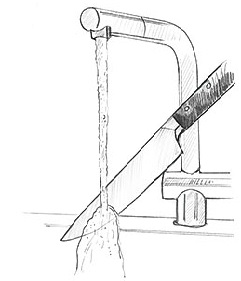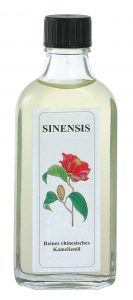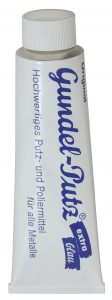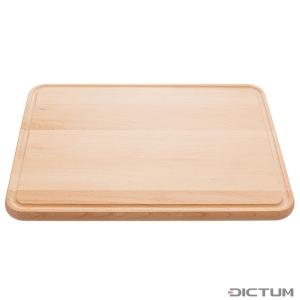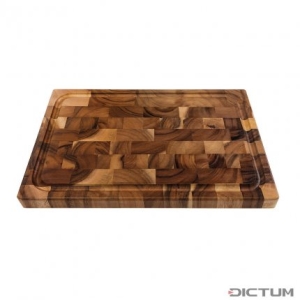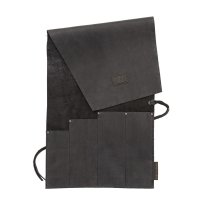Maintenance and Storage
Maintenance
Never clean high-quality knives in the dishwasher, even if they have »rustproof« blades! The atmosphere of high temperatures and salty water leads to intercrystalline corrosion which destroys the blade. The cleaning agents etch their way through the surface into the metal, creating small holes – recognisable by small, brown rust spots.
Knives must never be left or stored damp or wet. The sooner the knife is cleaned after use, the better. This is particularly true when you have cut acidic food like lemons or tomatoes.
Clean the knife by hand, rinsing it under lukewarm water and, if required, adding a little washing-up liquid. Use only the soft side of a sponge or a soft dishcloth. It is very important to dry the blade immediately.
In addition, the following rules should be observed when handling high-quality chef’s knives:
- Do not use the blade as a lever
- Do not cut frozen food
- Do not cut on hard surfaces, but on e.g. wooden boards
- Do not sharpen dry or on high-speed grinders
- Japanese kitchen knives must not be sharpened with a sharpening steel due to their blade hardness (hardness of the steel)! Use Japanese sharpening stones.
Even today, (not rustproof) carbon steel is still the blade material with the finest structure and highest possible degree of sharpness.
Maintain these knives by oiling them regularly with odourless, food-safe oil such as camellia oil (No. 705280). Do not use acidic oils such as olive oil for this.
Rust erasers (No. 711163) provide an effective means of removing surface rust from valuable knives without damaging the blades. Using water as a lubricant, the rust is »erased«.
Gundelputz (No. 705262) is a proven cleaning and polishing agent for all shiny metals (steel, stainless steel, aluminium, brass, copper, silver, gold, nickel, chromium etc.). It is also ideal for honing blades on leather, e.g. with strops, the Tormek sharpening system, etc.
Optimum cutting board
The correct cutting board – and this applies to all knives, not just original Japanese ones – is made of wood or plastic. Working on hard underlays, such as porcelain, marble or glass quickly dulls the blade. In our online shop we offer a wide range of chopping boards
Optimum cutting technique
Let the knife glide through the food without using much pressure. Use the entire length of the blade and make straight, pulling cuts. Cut soft food like ripe fruit, vegetables, fish, tender meat with a pulling cut whenever possible. The longer the cutting line, the lower the cutting resistance.
Your high-quality Japanese kitchen knife is not suitable for cutting up hard food. Avoid all breaking, bending and impact stress on the blade. Rough handling can cause the blades to break!
In Japan there are particularly robust and heavy knives called »Deba« for cutting up hard foods such as cartilage. If you want to cut something hard, like pumpkins, with a Japanese knife, this should be your first choice.
But you can also cut hard things with other Japanese knives, such as the popular »Santoku«. It is important to apply even pressure to the blade from above and not to tilt it.
Never try to push the material apart with the blade! When loaded from the side, the hard steel of the middle cutting layer tends to break away.
The usual cutting movements are also of little use with hard food. The back-and-forth movement poses the risk of bending thinly ground blades or their tips.
Storage
Store the knife separately in a cutlery box or knife block.
A knife rest (No. 718994) is a great way to always have your kitchen knives ready to hand: whether on the working surface or in the drawer. The blades are safely separated from each other thus stay sharper for longer.
A knife block (No. 718992) is another tried-and-tested variant for storing your high-quality kitchen knives in a way that is gentle on the blades.
We do not go for magnetic holders because the resulting magnetisation makes sharpening more difficult (the removed material sticks to the blade during sharpening).
Or follow the example of Japanese cooks who wrap their knives in cloths.
A practical alternative for safely storing your kitchen knives is a leather knife roll (No. 710410).

